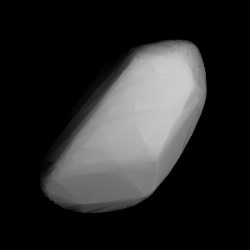 Shape model of Dobrovolsky from its lightcurve | |
| Discovery [1] | |
|---|---|
| Discovered by | L. Chernykh |
| Discovery site | Crimean Astrophysical Obs. |
| Discovery date | 19 August 1966 |
| Designations | |
| (1789) Dobrovolsky | |
Named after | Georgy Dobrovolsky (cosmonaut) [2] |
| 1966 QC ·1936 KK 1939 GR ·1943 SG 1946 NA ·1953 TC2 1953 VX3 ·1955 EJ 1956 PD ·1956 RT 1969 OF | |
| main-belt · Flora [3] | |
| Orbital characteristics [1] | |
| Epoch 4 September 2017 (JD 2458000.5) | |
| Uncertainty parameter 0 | |
| Observation arc | 73.51 yr (26,850 days) |
| Aphelion | 2.6309 AU |
| Perihelion | 1.7952 AU |
| 2.2131 AU | |
| Eccentricity | 0.1888 |
| 3.29 yr (1,203 days) | |
| 195.44° | |
| 0° 17m 57.84s / day | |
| Inclination | 1.9761° |
| 102.09° | |
| 214.93° | |
| Physical characteristics | |
| Dimensions | 7.809±0.077 km [4] 7.922±0.099 [5] 9.85 km (calculated) [3] 11.23±0.37 km [6] |
| 4.800±0.020 h [7] 4.811096±0.000005 h [8] 4.8111±0.0025 h [9] 4.812±0.001 h [a] 5.8 h [10] | |
| 0.1825±0.0243 [4] 0.185±0.031 [6] [5] 0.24 (assumed) [3] | |
| S [3] [11] | |
| 11.05±1.53 [11] ·11.800±0.080(R) [7] ·11.922±0.001(R) [9] ·12.2 [1] [3] [6] ·13.0 [4] | |
1789 Dobrovolsky (prov. designation: 1966 QC) is a Flora asteroid from the inner regions of the asteroid belt, approximately 8 kilometers in diameter. It was discovered on 19 August 1966, by Russian astronomer Lyudmila Chernykh at the Crimean Astrophysical Observatory in Nauchnyj on the Crimean peninsula. [12] The asteroid was named after cosmonaut Georgy Dobrovolsky. [2]